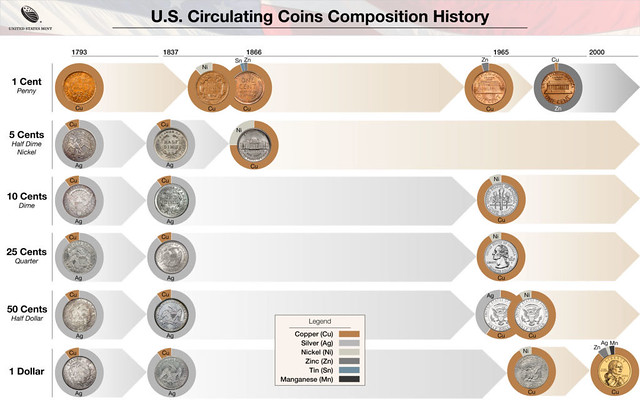
PREV ARTICLE
NEXT ARTICLE
FULL ISSUE
PREV FULL ISSUE
U.S. COIN COMPOSITION CHANGESAs a data guy I'm partial to a good infographic. A couple weeks ago we discussed a U.S. Mint website article which reviewed 100 years of silver dollar coinage. Here's another article with a decent infographic summarizing changes to U.S. circulating coin composition over the years. The article also has two nice image galleries showing coin production methods in the pre- and post-steam eras, plus a video of modern coin production. See the complete article online for more. -Editor The U.S. Mint has produced coins for this nation for over 225 years. Coin production evolved from slow horse- and man-powered machinery to fast computer-controlled machines. Explore the history of coin production and how the process changed through the years.
Coinage at the First Mint The Coinage Act of 1792 authorized the Mint to produce copper, silver, and gold coins for circulation. The Act specified that the government must buy the copper needed to coin half cents and cents (as raw material or as blank coins already the appropriate size for coining). But depositors such as banks and individuals provided the silver and gold. The silver and gold were either in the form of foreign coins or bullion that the Mint melted down and refined to the appropriate fineness for coining...
The Switch to Steam Power Two years after Peale returned, the Mint built steam-powered coining presses modeled after those used in Europe. A single person operated a press, dropping blank coins down a tube to feed between the dies. Coin production became a lot less labor-intensive, opening up many jobs to women.
Electricity and the Modern Age Today, the Mint follows the same basic process as it did 200 years ago, but with computer-controlled machines working at unbelievable speeds. One coin press produces 720 coins per minute, which means that the Philadelphia Mint produces 46,800 coins per minute if all of its 65 presses are operational. I'm not as big a fan of this graphic since it leaves out the equally important changes in size and weight over the years, such as the introduction of the small cent. This graphic also leaves out obsolete denominations such as the half cent and 2, 3 and 20 cent pieces. But it does a decent job for the subjects it does tackle. Look closely and you'll see each coin image is surrounded with a pie chart noting the breakdown of composition for each coin (most are alloys vs. pure metal). You can click on the image to see a larger version on our Flickr archive, or see the original at the link below (click that image to expand as well). -Editor
To read the complete article, see:
To read the earlier E-Sylum article, see:
Wayne Homren, Editor The Numismatic Bibliomania Society is a non-profit organization promoting numismatic literature. See our web site at coinbooks.org. To submit items for publication in The E-Sylum, write to the Editor at this address: whomren@gmail.com To subscribe go to: https://my.binhost.com/lists/listinfo/esylum All Rights Reserved. NBS Home Page Contact the NBS webmaster 
|

